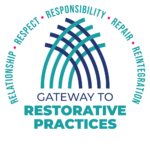Any time is the perfect time to try a new restorative response.
Here’s how a Modesto City School teacher at Shackelford used the simplest form of restorative practices.
Affective Statements in Action
“When two students had an ongoing issue at recess, we started to resolve the problem using I messages. Although the behavior did not change right away, the students began using I messages on their own. The conflict was not resolved right away, but it was a step in the right direction.”
— By Cohort 2 Site Team Member, Year 3, November 7, 2016
“I” messages provide the foundation of affective statements. This Tier 1 response is the most informal restorative response and can be used with all students. Affective statements are the easiest and most useful tool for building restorative classrooms and relationships.

Simply begin with an “I” statement and provide additional clarification with a feeling and a behavior. It is a personal statement made in response to someone else’s positive or negative behavior. It tells students how their behavior affects you or others.
Below are two examples of common situations and possible affective responses.
Two Examples of Affective Responses
Situation #1: Students are rough housing in the hallway
Affective Response: “I want everyone to feel safe here and I can see that what you’re doing is making some of the other kids nervous.”
Situation #2: A student calls another student a name
Affective Response: “That hurt my feelings and it wasn’t even directed at me. I’m wondering how what you just said fits in with the school’s commitment to respect.”
How can you use an affective restorative response today?
Sources:
- The Restorative Practices Handbook: for Teachers, Disciplinarians and Administrators, Bob Costello, John Wachtel, & Ted Wachtel, International Institute for Restorative Practices, 2009.
- Ed White Restorative Discipline Teacher’s Handbook. Page 16. [No author]. https://irjrd.org/restorative-discipline-in-schools/restorative-discipline-resources/
- Image: Cartoon Speech Bubble Clip Art [ux.stockexchange.com]

